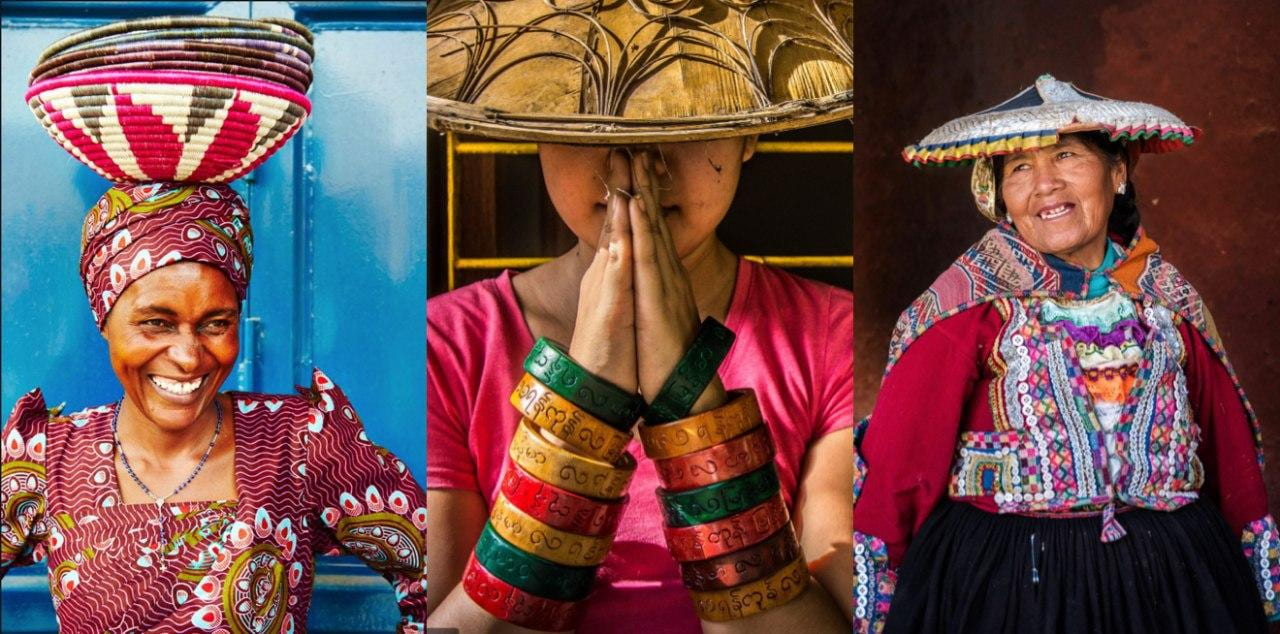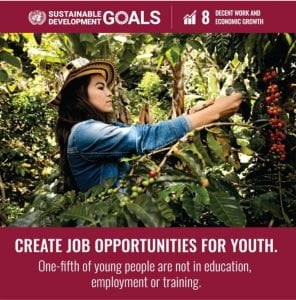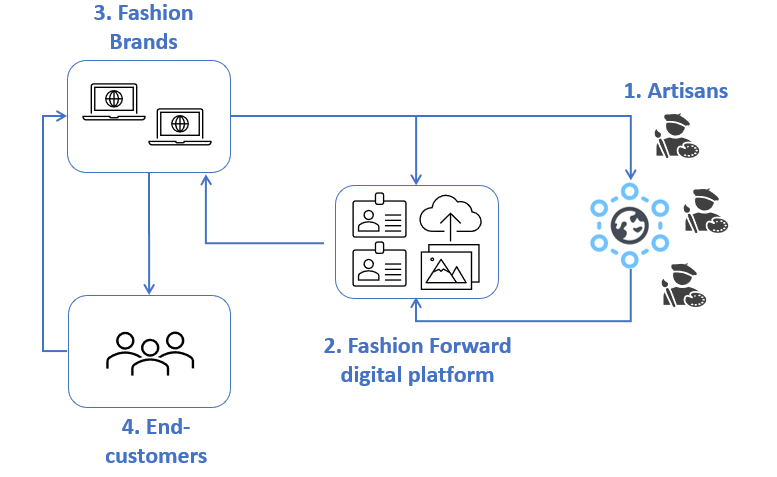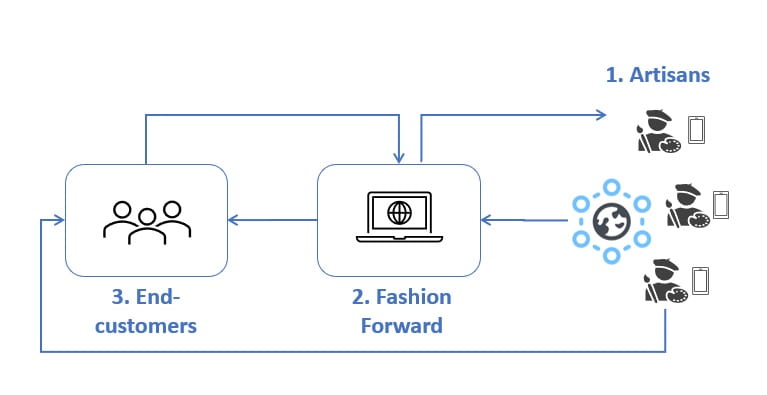Connecting the Polka Dots – Motivation behind Fashion Forward

Scrolling through an Instagram thread on a usual weekday we saw postings of fascinating, handcrafted pictures and embroideries on our everyday products – shoes, t-shirts, dresses – something we would purchase and cherish ourselves. We realized that there is a potential demand for such a form of art from both the brands and the customer. We further realized that there is a positive-impact possibility to matchmake the two via an elegant solution that will allow us to ride the wave of mass customization that brands are striving for, and promote the art of underprivileged artists in remote areas.
To elaborate, our platform/ app will provide income-generating opportunities for disadvantaged artists in developing countries, encourage gender equality, offer products in line with customer expectations for personalization, and satisfy customer desire to feel emotionally connected to products/story/artist. We hope it will even promote slow fashion and lower consumption as the customers will feel more attached to the item and the beautiful story behind it.
UN SDG goals are an important implication for our solution, and we plan to build our operations with these goals being a part of our DNA. UN SDG 1 (End poverty in all its forms everywhere), and UN SDG 8 (Promote inclusive and sustainable economic growth, employment and decent work for all) are the two SDG goals we will concentrate on and contribute to throughout building our venture.
There are several gaps we think our project could fill in the future – as we mentioned in the beginning, it helps meet customer demand for more personalized apparel as well as increased sustainability consciousness.
In the next 5 years, we assume that the customization and sustainability mindfulness trend will continue, allowing the platform to naturally grow in terms of assigned brands, artists, and invested customers. In the long-term the platform may create a precedent for a more inclusive retail ecosystem that creates more invested stakeholders – i.e. artists are viewed as partners, financial stakeholder rather than offshore workers, customers are emotionally connected to products, retailers operate as a force for good rather than being exploitative (a longstanding criticism of the industry).
Project Value Proposition and Goals
Our value proposition includes and depends on the following stakeholders:
Brands offer customers personalized products in line with the trend, promote the socially conscious cause that overall is of increasing appeal to the nowadays customer. We, therefore, think this relatively low-cost proposition will allow the brands to generate more sales and enjoy a positive impact on their brand’s name.

Artists: receive extra revenue sources and have access to a customer base and new markets.
Customers: feel emotionally invested in the product, receive personalized products, and feel invested in a social cause.
Sustainability and Financial Goals
Financial goals. We seek to cover initial costs and generate moderate profits through establishing and further increasing participation of local artists, brands, and customers in the sale of personalized products. The nature of this initiative is not to create high profit margins and fast-growing business within a short time-span, but to achieve a long-term yet dynamic ecosystem that is able to survive live and sustain itself on its own.
KPIs we will introduce to measure success: Profit margin, Contribution Margin, revenue generated by artists through platform, Artists, Brand and Customers acquisition rates, # of geographic regions covered by the platform.
Sustainability Goals – UN SDG indicators.


We plan to contribute to SDG goals through adopting purpose-driven, SDG-impactful business models, and we will concentrate on two – UN SGD 8 and UN SDG 1.
UN SDG 1 is about ending Poverty in all its forms everywhere. Our idea of connecting artists to brands helps in a sense that it creates additional channels of money generation for the under)privileged artists in different geographies, with a potential for artists to make their passion the sole and worthwhile source of income through getting access to brands’ marketing channels and customer base.
Indicators we will focus on are:
1.1.1 – Proportion of the population living below the international poverty line by sex, age, employment status and geographic location (urban/rural). To track success on this initiative we will
1.2.1. Proportion Population below the national poverty line, by sex and age.
UN SDG 8 – Promote inclusive and sustainable economic growth, employment, and decent work for all. We hope that our initiative will contribute to moderate, yet long-term economic growth in selected regions, provide more income generation opportunities for talented artists in remote locations without access to promotion and distribution channels, and even contribute to more gender equality as it will provide equal rights and access to brands’ resources.
Indicators we will focus on are: 8.3 (support productive activities, decent job creation, entrepreneurship etc.); 8.b & 8.b.1; 8.6; and 8.51 (increase average hourly earnings and decrease youth unemployment).
More than Needle and Thread – Crafting a Sustainable Business Model
There are two business models that Fashion Forward is currently exploring to help it achieve its goals of making the developing world artisan more of a financial and personal stakeholder in the apparel ecosystem. The first model (Business Model 1) concentrates on Fashion Forward’s role as a marketplace, building and connecting a portfolio of artisans to brands, thereby allowing artisans to generate money from selling designs to brands (and earning on a commission-per-sale basis), while simultaneously providing the brands with the ability to showcase their social-impact credentials through personalized access to artist profiles. The second model (Business Model 2), modelled after Soko, focuses on business innovation on the manufacturing side, with Fashion Forward acting as a social-conscious brand utilizing a pre-screened network of local artisans who produce and deliver the end-product to Fashion Forward distribution points. Artisans in this model receive a higher percentage of the end revenue versus industry standard (25-35% vs. 2-3%: http://scalable-impact.com/soko/#).
- Business Model 1 (Marketplace):

- Fashion Forward discovers artists and builds a digital database with artist profiles. Fashion Foward offers brands the chance to buy an artist’s artwork and profile (for a small one-time fixed fee per bundle of artworks) and incorporates this profile and related art customizations on the brand’s website through a built-in web feature. The brand offers a series of personalized customizations on its existing collection based on artists’ designs (example: calligraphy on a shoe, shirt lapel with a particular pattern). These customizations allow the brand to advertise itself as socially conscious (add-in feature is linked to artist profile and story) while customers receive new personalized products and cultivate an emotional connection to artist story and social-impact theme. The extra expenditure paid to customize a product with an artist’s design is split between the brand (lion’s share of revenue), the artist (small royalty), and the platform (small commission from each sale).
- Business Model 2 (Manufacturing Innovation):

- Fashion Foward shops and designers are based in different developing world localities. Artisans are scouted out and recruited to the platform, where they are introduced to, provided training on usage, and given the Fashion Foward mobile application. The Fashion Forward mobile application teaches and allows artisans to both photograph their products and receive design specifications from Fashion Forward designers. Designers utilize a virtual factory using mobile phones to coordinate artisans making use of a demand-responsive manufacturing model. Artisans receive purchase orders, manage inventory and delivery, and get paid directly on their mobile phones. A cloud system matches demand with available capacity. End products are sold under the FF brand and revenue is shared with local artisans (providing them with a higher revenue share than the industry average).
Tailoring the Ecosystem – Aligning Stakeholder Incentives
A key to the viability of both Fashion Forward’s business models is aligning different incentives of stakeholders (end-customers, brands, artisans, designers) in that way that promotes the end goal of financially supporting underprivileged artists in an economically sustainable way that engages the rest of the ecosystem.
- Business Model 1: In this model the financial incentives of the brand and artisans are directly aligned as more profit generated by the brand through selling personalized products is directly linked to the profit made by impact artists (due to the commission model) as well as the platform. In addition, the brand is incentivized to promote Fashion Forward as this allows it to advertise its social-impact credentials (performs a similar role to marketing, advancing its ability to generate more sales) while customers enjoy a larger product selection, an emotional experience (connection to end artists through access to artist profiles), and the feel-good factor from being involved with a social impact enterprise. On the flip-side of the relationship, the artist is incentivized to produce good quality artworks/designs to ensure long-term contracts (income) from relationships with brands which has the added benefit of giving him/her access to a larger market and the chance to develop a reputation with large brands. The platform takes risks and complications away from both parties in dealing with each other by doing preliminary due diligence and finding artists as well as coordinating with brands on the behalf of artists.
- Business Model 2: Financial and sustainability goals are linked in this business model since the producers make a higher % of revenue share from producing for Fashion Forward versus producing for the mass market and their revenue is linked to customer purchases of the Fashion Forward brand. Artists are similarly incentivized to produce good quality works in order to secure contracts with brands which ensures them a higher % of revenue share than selling to the main market (partly by cutting out middlemen) and also giving them access to a larger market. The brand is incentivized to cultivate long-standing relationships with artisans to ensure high quality and design standards are upheld. The Fashion Forward brand ultimately wants to engender customer loyalty and differentiate from competitors while end-customers are looking for quality assurance, unique products, emotional attachment to products, and the feel-good factor from sustainability. Desire for a diverse product selection is driven by in-house designers working for Fashion Forward who are motivated by their compensation and a chance to build a reputation.
A Needle in a Haystack – Dealing with Information Uncertainty
There are several major uncertainties associated with both Fashion Forward business models. The main uncertainties of the first model are more related to the willingness of brands and artists to deal with the platform while the second model is more centred around quality concerns and brand differentiation.
- Business Model 1: The main information uncertainties and associated mitigating factors surrounding the brand are the following:
- Readiness of brands to collaborate with local artists via platform and vice versa. This uncertainty is mitigated by removing risk of engagement by screening brands for ESG credentials (to target brands more open to collaboration in the first place) and initially proving Fashion Forward’s credibility through successful engagement with one brand (word of mouth effect). Entering long-term contracts with artists will, we believe, give them the opportunity to realise a more sustainable long-term source of income while the ease of use of the Fashion Forward platform for finding and managing new artist designs will help brands differentiate and innovate while flaunting their social impact credentials.
- Readiness of brands to pay a commission to artists on each sale. Fashion Forward will copyright the database and website/artist profile that is added as an appendage to the brand’s site. Since the brand is just as incentivized by this appendage to advertise their social impact credentials as it is by offering new designs to customers, it has an incentive to be honest in its affairs as non-collaboration will lead to the platform removing the built-in artist profile from the brand’s website in addition to ending future collaboration.
- Ability of impact artists to digitalize products (otherwise platform will have to spend too much time and money on this process). Fashion Forward will provide free online tutorials to artists as well as in-person training (when possible) to help them digitalize their products.
- Business Model 2: The main uncertainties and associated mitigating factors surrounding the brand for the second business model are the following:
- Channels of distribution (how are we going to distribute the product). Fashion Forward will start out small with small stores (distribution points) and then scale as demand grows. Fashion Forward will also build e-commerce relationships with distributors
- How to differentiate brand vs. competition. A lot of investment will be out marketing campaign to create a strong differentiated brand.
- How to make sure the products meet high quality and social responsibility standards. Fashion Forward will conduct random checks of artisans as well as communicate the quality and social standards expected from artisans. Artisan products will be rated on quality and social metrics at point of collection by Fashion Forward and high-scoring artisans will be preferred for future orders.
One Size does not Fit All – Shortcoming of the Business Model
The business models presented have certain specific shortcomings which Fashion Forward seeks to address in the following ways:
- Business Model 1:
- Brands could steal designs and stop paying commission to artists/platform. Fashion Forward is selling artists’ stories as a built-in add-in to the brands’ sites. Since brands are very interested in this market model to boost their social impact credentials, they will want to retain these features as these features are indirectly a main driver of revenue.
- Digitalization of designs/artists is labour and time intensive, there is a lot of responsibility attached to the person compiling the database. Fashion Forward will raise funds beforehand to support building of platform and conduct a thorough interviewing of the head compiler.
- Brands’ operations are not suited for customization as this requires re-jigging of machinery etc. Brand chooses a finite number of designs which are adapted to brand’s machinery and processes beforehand. Designs to be used are subject to compatibility with brands processes/machinery (i.e. brands will choose those designs in the first place).
- Business Model 2:
- Quality assurance of products not guaranteed. Artisans are filtered beforehand and design samples are selected on the basis of their quality. Quality scores are generated and good quality artisans are favoured for future orders.
- Risk borne by in-house FF designers who have to predict customer preferences, and potential distribution issues. Fashion Forward assumes the risk of design but will try to mitigate through choosing competent and trendy head designers. Regarding distribution, artisans have the connections and means to sort out small scale distribution themselves.
- Hard to make sure that artisans are complying with high level of social environmental standards. Random checks will be used to enforce a high level of compliance with offending artisans removed from the platform.
Built to Last – Scaling the Business
We assume that both business models will allow to scale the business in the nearest future (up to 5 years). Business Model 1 could further expand the idea by including many aspects of artistry: modularization of artists’ design and story page portal will also allow for quick add-in of the built-in page to brands’ websites, grow artist and brand database in tandem. We also expect to build customer awareness by promoting and connecting to stories and allowing customers to boast about their progressiveness on our Instagram page and through the network of Instagram influencers.
At the same time Business Model 2 will enable to develop the database of artisans and more in-house designers and distribution points, e.g. shops and e-commerce partnerships with distributors.
#FashionForward – 5-Year Plan
We believe that today is the best time to launch Fashion Forward. According to the latest research, customers are much more likely to engage with a brand that offers a personalized good. At the same time, consumers became more aware of the social implications in the clothing industry. Though most fashion companies are becoming more transparent about the environmental and social impact of their businesses, yet few are comfortable to discussing social issues. But increasing pressure from the customer side shifts them towards eco-friendly and sustainable production and pushes them to become ESG compliant.
Coming to a Pop-up Store Near You! – Experimentation and Launch
In order to launch Fashion Forward, we will first focus on a unique pilot project with a certain number of initial artists targeted. We will launch a beta version website and application that will allow customers to filter designs. We will also leverage out use of network to reach out to potentially interested brands, starting with a limited number of social impact producers, pivoting brands and then reaching out larger companies. Our company will be bootstrapped in the beginning, we will produce and ship several trial products before launching an official application.
Teymour Dajani, Nataliya Gorbunosova, Azamat Satyvaldiev, Julia Chinakaeva
The trade-off between Model 1 and 2 is interesting in that the first one offers access to distribution networks of big brands whereas the second one offers greater share of the profit for the artist. Ideally, a business would choose model 2 but also be open to partnerships with big brands.
I find it interesting in Model 1 that fashion brands will have to tailor their operations to make the new designs – I wonder if this will be more cost-effective than giving the basic materials to the artists to make the products (at a much smaller scale and at a steeper price).
I also think the digitalization of artists’ works will be a concern in the second model from a digital merchandising point of view.